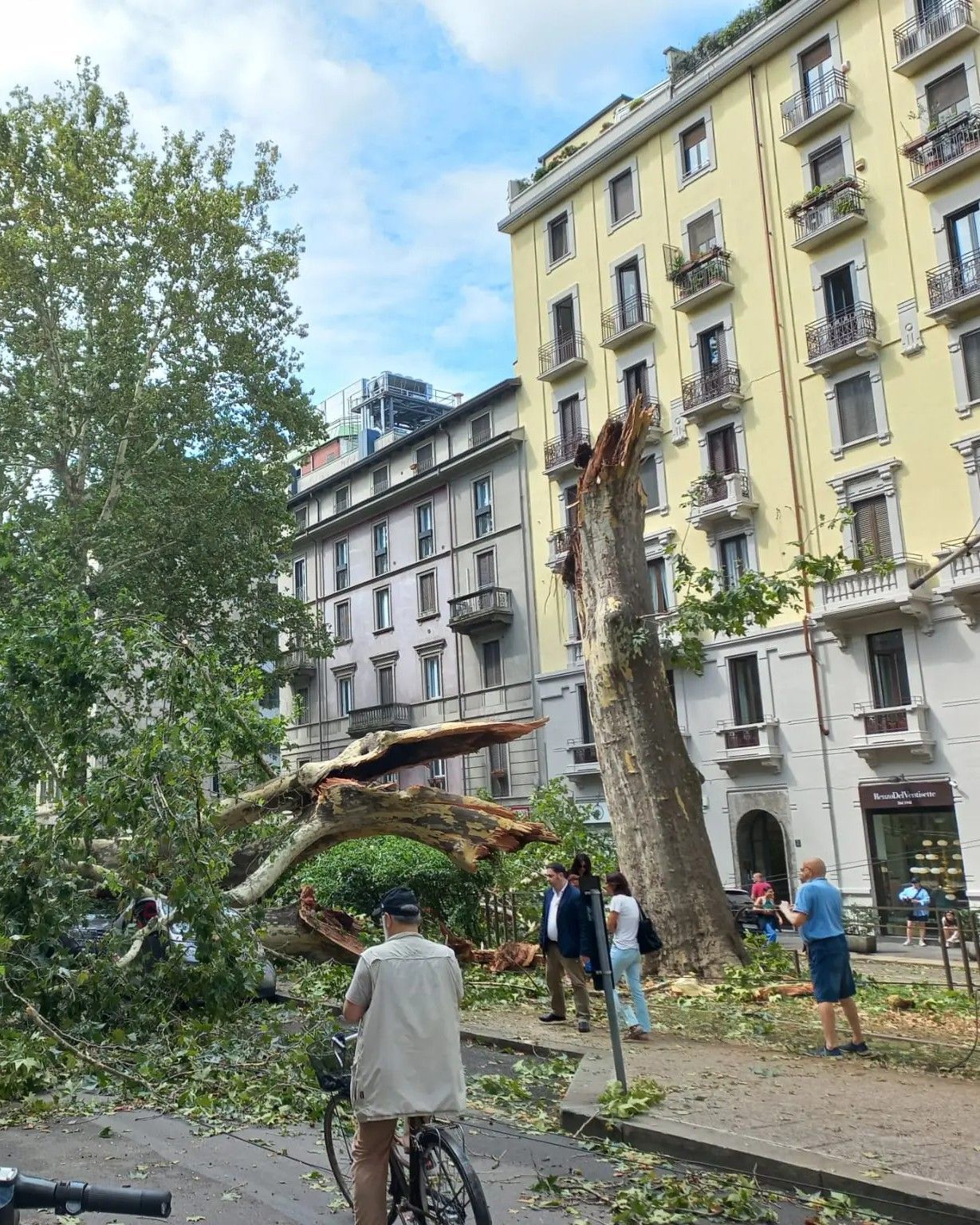
What will happen to Milan's fallen trees? Among the 5,000 fallen trees is a monumental oak tree that is almost 150 years old
This summer in Milan there have been two extreme weather events in the space of just a month. At the end of July, a violent cloudburst hit the city, with very strong winds and heavy rain, causing extensive damage to homes and infrastructures in several neighbourhoods. The same happened on the afternoon of Saturday, 26 August. Following these exceptional weather events, the government declared a 12 month-long state of emergency in Lombardy, at the same time allocating around 9 million euro to deal with the inconveniences caused. «What I am seeing now is not normal, we can no longer deny it, climate change is changing our lives,» commented Beppe Sala. While waiting to receive the funds, the municipality has taken charge of several initiatives to repair the damage suffered, in addition to the most urgent interventions by the Civil Protection and the Fire Brigade.
Milano Per Gli Alberi
The Milano per gli alberi fundraiser was launched with the aim of replanting the approximately 5,000 trees that fell during the last two storms, mainly in the north-eastern quadrant and the south-western area of the city. The estimated damage caused to the city's tree heritage exceeds 15 million euro. Milan's public green extends over an area of more than 25 million square metres, and according to a census there are more than 250,000 trees - distributed among parks and boulevards, among other things. «The city's greenery requires a system of real care and valorisation, socially participated, with the active involvement of citizenship, and the newly established Fund is intended to be a tool for this,» said Councillor for the Environment Elena Grandi.
What will happen to Milan's fallen trees?
Oggi impossibile trovare una via dove non sia caduto un albero.#Milano pic.twitter.com/edcIHEqTAI
— Stefania (@steginger88) July 25, 2023
It is not easy to understand why some trees are uprooted by storms more easily than others, but as Grandi pointed out in the council meeting, it has «nothing to do with the upkeep of the city's greenery.» Usually, the most isolated plants are the ones to be more prone to falling, while in areas with a greater density of trees the damage is usually less, as having a bigger underground system makes it easier for it to stay compact. This trend was noticed in Milan's Parco Nord after the extreme weather events of July and August. Taller and thicker trees, being more exposed to gusts of wind are more likely to be uprooted (the foliage produces a sort of 'sail effect' that contributes to the plant falling). In recent years, hundreds of thousands of new trees have been planted in Milan as part of the Forestami project, an initiative promoted by the city administration among others, which aims to reach 3 million new trees by 2030. In the coming months, fallen or excessively damaged trees in the city will be felled and new ones planted in their place, but it will still take decades to return to a situation similar to the one before the two storms.
The fall of Milan's hundred-year-old trees
@alessandro.beloli Nella notte del 25 luglio 2023 una violenta tempesta ha colpito Milano. Ecco alcuni dei numerosissimi danni avvenuti in città. Una delle evidenze maggiori sono decine e decine di alberi sradicati. #milano #milan #clima #climate #climatechange #distruzione #danni #pericolo #danger #destruction #tempo #meteo #meteorologia #grandine #tempesta #uragano #tornado #temporale #damages #rischio #albero #alberi #cambiamentoclimatico #cambiamenticlimatici #estate #riscaldamentoglobale #ambiente #natura Powerful songs like action movie music - Tansa
One of Milan's 13 'monumental' trees has also been irreparably damaged: it is a Himalayan Cedar, a plant native to the western slope of the Asian mountain system, 23 metres high and over 110 years old, located in the garden of Villa Reale in the Porta Venezia district. This area is home to the largest number of monumental trees registered by the municipality, including a 35-metre plane tree - one of the tallest in the city. To be 'monumental', trees must possess certain specific characteristics (concerning size, rarity, conformation and age), or be linked to significant historical events; those present in Milan are all between 90 and 200 years old. Although they are not formally considered 'monumental' (there is a real bureaucratic process to have them recognised as such), a number of centuries-old trees uprooted or damaged due to the two storms have been reported, including a fallen oak tree in the Indro Montanelli Gardens aged between 130 and 150 years of age.
How do you save a fallen tree?
Before planting a new one, when a large tree is uprooted it is chopped into smaller pieces so that it can be transported more easily, and the wood is given away for free, so that it is not thrown away - for the benefit of associations and businesses in the sector, educational institutions and non-profit organisations. The municipality then catalogues all fallen trees, as well as damaged ones, drawing up a medium-long term plan for urban reforestation: «We will also have to think about where to replant the trees in relation to the quality of the soil: some of those that fell we saw had roots that were too small in relation to their size,» Grandi points out, stating the two storms should be the starting point for «redesigning the trees for the next 30 years.»














































